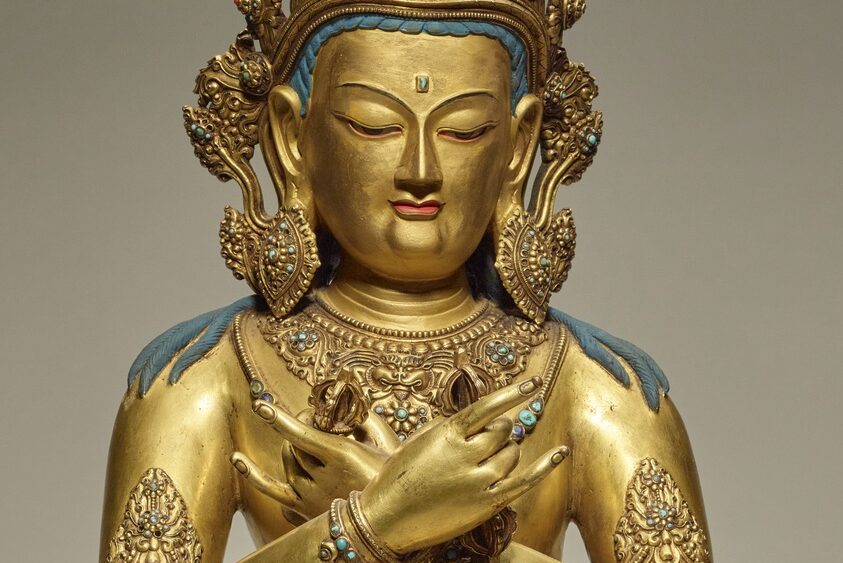In her chic apartment on New York’s Upper East Side, Alice Kandell likes to retreat to a room where flickering candles softly illuminate gilded sculptures inlaid with coral, turquoise, and other semiprecious stones. The walls are hung with exquisitely painted images of serene deities and ferocious guardians. A fine silk canopy floats above an altar arrayed with ritual objects—the centerpiece of a room that reflects the art and faith of Tibetan Buddhism.
Kandell has formed several such collections over the years. In 2011, she donated hundreds of Buddhist objects to the Smithsonian’s National Museum of Asian Art, in Washington, D.C., establishing a permanent Tibetan shrine within their collection. At the time, his Holiness the Dalai Lama, the spiritual leader of Tibetan Buddhism, expressed his gratitude that Kandell had not only preserved Tibetan objects but was sharing them with the American public.
On September 14, when “The Tibetan Buddhist Shrine Room: The Alice S. Kandell Collection” opens at Mia, she will have created another landmark of devotional art from the top of the world. More than two hundred gilt-bronze sculptures, paintings, silk hangings, and carpets created in Tibet and Mongolia between the 1300s and early 1900s will be arranged in the style of a private household shrine. Typically a space for offerings, prayer, and other rituals, here the shrine is a serene environment within the galleries for contemplation, a glittering gift of sacred beauty representing more than four decades of collecting.
Moved by Sacred Beauty
Kandell’s interest in Tibetan Buddhism began in 1963, when her college friend Hope Cooke married the crown prince of the Himalayan kingdom of Sikkim, now part of India and a haven of Tibetan Buddhism. Two years later, as Kandell was pursuing a doctorate in psychology at Harvard University, she was invited to attend the couple’s coronation. Given her access to an American queen-to-be, Kandell was approached by Redbook and other publications to photograph the event, despite having no formal photography experience. She took lessons, and did well enough when she arrived in Sikkim that the king himself asked her to document the country’s culture.
Over the next eight years, she returned many times to the region. Moved by the sacred beauty of the Buddhist shrines there, she began to collect objects back in the United States. As her collection grew, she devoted space within her Manhattan apartment to re-create the sanctuaries.
In 2017, the National Museum of Asian Art held a special exhibition, “Encountering the Buddha,” involving its shrine room. Matthew Welch, Mia’s Mary Ingebrand-Pohlad Deputy Director and Chief Curator, met Kandell at the opening reception and struck up a conversation. He was astonished to hear that she had continued to collect and had managed to assemble yet another shrine at home.
Welch and Kandell stayed in touch. In the summer of 2019, Kandell visited Mia and met with the Tibetan community in the Twin Cities. That fall, a month before Katie Luber became Mia’s new director, Luber, Welch, and trustee Nivin MacMillan visited Kandell in New York. Through the travails of the pandemic, Welch and Kandell continued to discuss the possibility of her second shrine finding a permanent home at Mia. In 2023, an agreement was reached, and some 228 objects were carefully packed, crated, and shipped to Minneapolis.
A Bridge Between Worlds

Tibet, Thangka with 21 manifestations of Tara, 19th century, pigments on silk. Promised Gift of Alice S. Kandell, L2023.76.198
The multi-sensory experience of the shrine room at Mia, from sound to lighting to the almost immersive installation, restores a relationship with these objects. Here, they are in context with each other, not encased in isolation or placed on pedestals. Kandell’s unique gift, evoking the heart of a well-to-do Tibetan household, helps explain the interrelated role of devotional objects in Tibetan religious practice—a faith that in recent years has found its way to Minnesota.
Mia has worked to connect these objects with the Tibetan community here, which now numbers more than 5,000 people. Over the summer, a group of Tibetan Buddhist nuns from the Jangchub Choeling Nunnery in southern India gave a presentation to museum staff, sharing personal stories, explaining their routines and rituals.
In the week leading up to the opening of the shrine room at Mia, the nuns will be creating a mandala in the museum’s Target Atrium, creating from memory a design of the cosmos in colored sand. A form of devotion, an act of meditation, and a work of art—albeit temporary. One week after finishing, they will bag up some of the sand and give it to onlookers, a token of goodwill that has become a public mandala-making tradition in the United States and elsewhere. The rest will be taken to the Mississippi River, the nearest body of flowing water, and ritually returned to the earth.
Everything vanishes, the Buddha taught, nothing is permanent. The Tibetan Buddhist Shrine Room at Mia will remain in its current installation for a year and then revisited. The collection will remain together in any case, a testament to faith and beauty, the power to inspire and be inspired.
“The Tibetan Buddhist Shrine Room: The Alice S. Kandell Collection” opens on the second floor of Mia on September 14.


